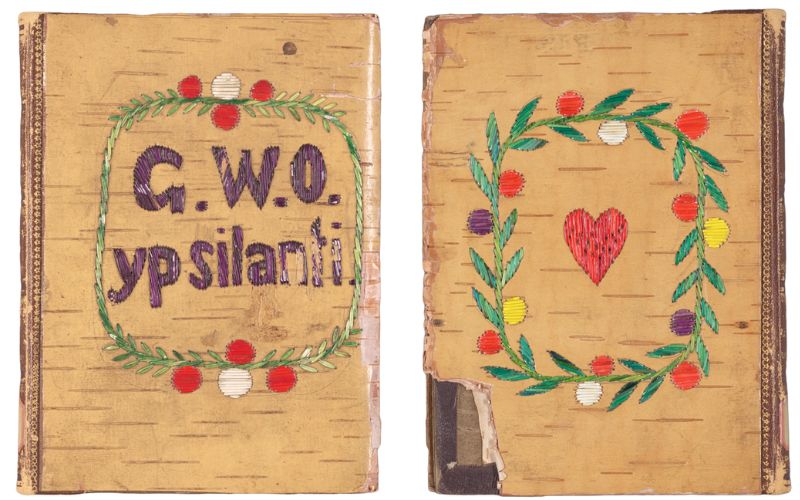
- Details
- By Kaili Berg
From never-before-exhibited drawings to pages from the Algonquin-language Bible, “Boundless,” a multimedia Native American art exhibition, is on display at the Mead Art Museum at Amherst College until Jan. 7, 2024.
“Boundless” gathers the works of more than 150 artists to tell a story of creativity and resistance across the centuries, including sculptures, historical and contemporary writing, photographs, quillwork, musical scores, basketry, and more. At times, the exhibit incorporates objects by non-Native creators to further its inquiries.
“There were so many key items that really inspired me. Because I was doing both Indigenous works and a few non-Indigenous made works in the collection, I focused on works that connected artists,” Heid Erdrich (Ojibwe), a poet and writer who curated the exhibit, told Native News Online.
The exhibition includes items from the Amherst College Collection of Native American Literature and the Mead’s collection, along with key loans from the Northeast region and beyond. Reading rooms within the exhibition even offer guests a chance to engage with Native American-authored and illustrated books.
Erdrich has been working on the exhibit since 2020.
“It was quite the challenge,” Erdrich said. “The thing that was the hardest was developing relationships with Indigenous artists in the area since I was not living on the east coast. I got pointed in the right direction and met some wonderful allies.”
“Boundless” hosts a number of unique objects by authors, artists, and musicians, including drawings by Mary Sully (Dakota), writing by Fritz Scholder (Luiseño), and pages from the Mamusse Wunneetupanatamwe Up-Biblum God, a 1663 Algonquin-language Bible created by a team that included three Indigenous translators and a Nipmuc printer.
Erdrich explained that the Algonquin Bible, also called the Eliot Indian Bible, was the first Bible printed in America. It also became the first translation of the Christian Bible into an Indigenous American language, translated by missionary John Eliot. A Nipmuc man, James the Printer, set the print, translated, operated the press, and distributed the book.
“He touched each of the pages,” Erdrich said. “It was just a great experience to see the ancestor's work and how often do we get to know something like that when we see things that have been made anonymous in museum collections.”
Help us ensure that the celebration of Native Heritage never stops by donating here.
“Boundless” was developed in dialogue with an advisory committee that includes members from the Nipmuc, Wampanoag, Shinnecock, and Mohegan Tribal Nations. The committee received support from staff at Mead Art Museum, Amherst College Archives and Special Collections, and the Five Colleges.
“The exhibition really tries to show all of the connections between the people who work in creative art programs and individual artists, which has helped enormously,” Erdrich said.
The second iteration of “Boundless” will take place this spring at the Mead Art Museum and will focus on more of works from the Northeast Tribes, including Shinnecock, Nipmuc, and Wampanoag artists. It will also expand to include global Indigenous work from Mexico, Australia Aboriginal, and the Amazon.
“It will make the connection on concerns we all have, especially around language and land,” Erdrich said. “It will have a bit of a different feel to it and will be a smaller exhibition.”
More Stories Like This
Over 150 Tribal Museums Participate in Fourth Annual Celebration of Native LifeNew Book Showcases 250 Images by Indigenous Photographers Spanning Two Centuries
Five Native American Chefs You Should Know
Short Film Documents First Full Kayak Run of the Klamath After Dam Removals
Joy Harjo Honored With Portrait of a Nation Award at Smithsonian Gala
Help us tell the stories that could save Native languages and food traditions
At a critical moment for Indian Country, Native News Online is embarking on our most ambitious reporting project yet: "Cultivating Culture," a three-year investigation into two forces shaping Native community survival—food sovereignty and language revitalization.
The devastating impact of COVID-19 accelerated the loss of Native elders and with them, irreplaceable cultural knowledge. Yet across tribal communities, innovative leaders are fighting back, reclaiming traditional food systems and breathing new life into Native languages. These aren't just cultural preservation efforts—they're powerful pathways to community health, healing, and resilience.
Our dedicated reporting team will spend three years documenting these stories through on-the-ground reporting in 18 tribal communities, producing over 200 in-depth stories, 18 podcast episodes, and multimedia content that amplifies Indigenous voices. We'll show policymakers, funders, and allies how cultural restoration directly impacts physical and mental wellness while celebrating successful models of sovereignty and self-determination.
This isn't corporate media parachuting into Indian Country for a quick story. This is sustained, relationship-based journalism by Native reporters who understand these communities. It's "Warrior Journalism"—fearless reporting that serves the 5.5 million readers who depend on us for news that mainstream media often ignores.
We need your help right now. While we've secured partial funding, we're still $450,000 short of our three-year budget. Our immediate goal is $25,000 this month to keep this critical work moving forward—funding reporter salaries, travel to remote communities, photography, and the deep reporting these stories deserve.
Every dollar directly supports Indigenous journalists telling Indigenous stories. Whether it's $5 or $50, your contribution ensures these vital narratives of resilience, innovation, and hope don't disappear into silence.
 The stakes couldn't be higher. Native languages are being lost at an alarming rate. Food insecurity plagues many tribal communities. But solutions are emerging, and these stories need to be told.
The stakes couldn't be higher. Native languages are being lost at an alarming rate. Food insecurity plagues many tribal communities. But solutions are emerging, and these stories need to be told.
Support independent Native journalism. Fund the stories that matter.
Levi Rickert (Potawatomi), Editor & Publisher

